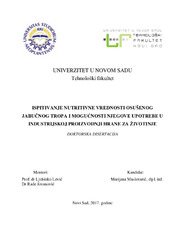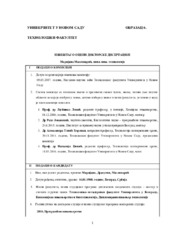Приказ основних података о дисертацији
Ispitivanje nutritivne vrednosti osušenog jabučnog tropa i mogućnosti njegove upotrebe u industrijskoj proizvodnji hrane za životinje
A study on the nutritive value of dried apple pomace and possibilities for using its utilization in the industrial production of animal feed
| dc.contributor.advisor | Lević, Ljubinko | |
| dc.contributor.advisor | Jovanović, Rade | |
| dc.contributor.other | Tepić-Horecki, Aleksandra | |
| dc.contributor.other | Džinić, Natalija | |
| dc.contributor.other | Lević, Ljubinko | |
| dc.contributor.other | Jovanović, Rade | |
| dc.creator | Maslovarić, Marijana | |
| dc.date.accessioned | 2017-10-12T15:07:41Z | |
| dc.date.available | 2017-10-12T15:07:41Z | |
| dc.date.available | 2020-07-03T13:55:48Z | |
| dc.date.issued | 2017-09-28 | |
| dc.identifier.uri | https://nardus.mpn.gov.rs/handle/123456789/8662 | |
| dc.identifier.uri | http://www.cris.uns.ac.rs/DownloadFileServlet/Disertacija15009833394735.pdf?controlNumber=(BISIS)104918&fileName=15009833394735.pdf&id=10322&source=NaRDuS&language=sr | sr |
| dc.identifier.uri | http://www.cris.uns.ac.rs/record.jsf?recordId=104918&source=NaRDuS&language=sr | sr |
| dc.identifier.uri | http://www.cris.uns.ac.rs/DownloadFileServlet/IzvestajKomisije150098335792065.pdf?controlNumber=(BISIS)104918&fileName=150098335792065.pdf&id=10324&source=NaRDuS&language=sr | sr |
| dc.description.abstract | Apple pomace is a by-product of the industrial production of apple juice, amounting to approximately 20-30% of freshly processed apples. Several million tonnes of apple pomace is produced in the world annually. Fresh apple pomace is characterised by high sugar and moisture content, which makes it susceptible to microbial contamination, uncontrolled fermentation and spoiling. Despite increasingly stricter legal regulations in managing biodegradable waste, large quantities of apple pomace are still being disposed of at landfills, posing a serious environmental issue. Since apple pomace has a certain nutritive value, it seems necessary to consider possibilities for using it as animal feed. The main goal of this research was to examine the possibility for using dried apple pomace as animal feed, i.e., as a raw material in the industrial production of animal feed. Accordingly, the nutritive value of dried apple pomace was examined, along with the process of pelleting, since pelleting is one of the most common technological procedures in the industrial production of animal feed. The testing of the chemical composition of dried apple pomace, used to determine its nutritive value, included the analyses of the content of raw proteins, raw fats, raw fibres, ash, neutral detergent fibres (NDF), acid detergent lignin (ADL), lignin, total sugars, individual sugars – fructose, glucose and sucrose, essential amino-acids, vitamins and mineral elements. When compared with the majority of commonly used animal feeds, the dried apple pomace was found to contain large amounts of raw fibres and sugars and small amounts of proteins and fats. In accordance with the determined nutritional composition of the dried apple pomace, concentrate mixtures for fattening pigs were prepared, after which a trial was performed to examine the effect of feeding the animals on the mixtures containing dried apple pomace in different concentrations on the production performance of the fattening pigs. The results of the feeding trial showed that adding 7% of dried apple pomace in the growing period and 10% in the finishing period had no negative effects on the animal health, production and meat yield. In the next part of the research, the dried apple pomace was pressed into pellets, with three starting moisture contents in the unpelleted material – 10%, 13% and 16%. The examination of the produced pellets showed that they had very good physical quality in terms of the pellet durability index (PDI) and hardness. The value of PDI exceeded 99% for all three starting moisture contents. The bulk density of the pelleted dried apple pomace was nearly twice as large as it was before pelleting. Increasing the moisture content in the dried apple pomace from 13% to 16% resulted in lower temperatures and energy consumption in the process of pelleting. The goal of the next part of the research was to examine the effect of adding apple pomace into the concentrate mixture models consisting of corn and sunflower meal on the physical quality of the obtained pellets, the specific electricity consumption of the pellet press and the temperature of the pellet press die. Three concentrate mixture models were prepared for the test, comprising 0%, 10% and 20% of dry apple pomace. The mixtures were conditioned by adding water to reach the moisture content of 13%, 15% and 17% and pelleted at three settings of the press die (8, 24 and 30 mm). Therefore, three parameters were varied at three levels, in a full factorial experimental design. The dependent variables (response variables) were: PDI, pellet hardness (H), dust content in the pellets, bulk density of the pellets, matrix temperature of the pellet press and the specific energy consumption of the pellet press. The results showed that adding dried apple pomace into the model concentrate mixtures led to a significant increase in pellet quality, especially in terms of increasing the PDI value and decreasing the dust content. The results of the analysis of standard scores (SS) showed that the optimum values for pellet quality, specific energy consumption and temperature of the press die were obtained for the model concentrate mixture containing 10% of dried apple pomace, using 30 mm press die and with 17% of the starting moisture content. Good results were also obtained for the model concentrate mixture containing 20% of dried apple pomace, using 24 mm press die and with 17% of the starting moisture content. To define the effect of the concentration of dried apple pomace in the model mixtures, the press die thickness and the starting moisture content on the change of the response variables, the response surface methodology (RSM) was used. The analysis of variance (ANOVA) of the response models for each of the analysed quality parameters and pelleting processes, showed which of the process parameters (percentage of apple pomace in the concentrate model mixtures, press die thickness and starting moisture content) had statistically the biggest effect on creating the mathematical response models, presented in the form of the second order polynomial (SOP). The results of this research showed that the increase in the percentage of dried apple pomace, press die thickness and starting moisture content led to an increase in PDI value, hardness (H) and bulk density of the pellets and a decrease in the content of dust in the pellets. The increase in the share of apple pomace in the model mixtures and in the die thickness of the pellet press led to an increase in the specific energy consumption and die temperature. On the other hand, the increase in the starting moisture content led to a decrease in the specific energy consumption and die temperature. In the last part of the research, on the basis of the determined nutritive value of the dried apple pomace the author made a calculation, in terms of optimising the concentrate mixtures containing dried apple pomace in the optimum amount for feeding particular species and categories of farm animals. The results suggest the way of practical utilization of dried apple pomace in feeding farm animals as well as in the industrial production of animal feed. | en |
| dc.language | sr (latin script) | |
| dc.publisher | Универзитет у Новом Саду, Технолошки факултет | sr |
| dc.rights | openAccess | en |
| dc.rights.uri | https://creativecommons.org/licenses/by-nc/4.0/ | |
| dc.source | Универзитет у Новом Саду | sr |
| dc.subject | Jabučni trop | sr |
| dc.subject | Apple pomace | en |
| dc.subject | hrana za životinje | sr |
| dc.subject | peletiranje | sr |
| dc.subject | smeše koncentrata za ishranu životinja | sr |
| dc.subject | tovne svinje | sr |
| dc.subject | animal feed | en |
| dc.subject | pelleting | en |
| dc.subject | feed mixtures | en |
| dc.subject | fattening pigs | en |
| dc.title | Ispitivanje nutritivne vrednosti osušenog jabučnog tropa i mogućnosti njegove upotrebe u industrijskoj proizvodnji hrane za životinje | sr |
| dc.title.alternative | A study on the nutritive value of dried apple pomace and possibilities for using its utilization in the industrial production of animal feed | en |
| dc.type | doctoralThesis | en |
| dc.rights.license | BY-NC | |
| dcterms.abstract | Левић, Љубинко; Јовановић, Раде; Тепић-Хорецки, Aлександра; Джинић, Наталија; Левић, Љубинко; Јовановић, Раде; Масловарић, Маријана; Испитивање нутритивне вредности осушеног јабучног тропа и могућности његове употребе у индустријској производњи хране за животиње; Испитивање нутритивне вредности осушеног јабучног тропа и могућности његове употребе у индустријској производњи хране за животиње; | |
| dc.identifier.fulltext | http://nardus.mpn.gov.rs/bitstream/id/40703/IzvestajKomisije11518.pdf | |
| dc.identifier.fulltext | https://nardus.mpn.gov.rs/bitstream/id/40703/IzvestajKomisije11518.pdf | |
| dc.identifier.fulltext | https://nardus.mpn.gov.rs/bitstream/id/40702/Disertacija11518.pdf | |
| dc.identifier.fulltext | http://nardus.mpn.gov.rs/bitstream/id/40702/Disertacija11518.pdf | |
| dc.identifier.rcub | https://hdl.handle.net/21.15107/rcub_nardus_8662 |



